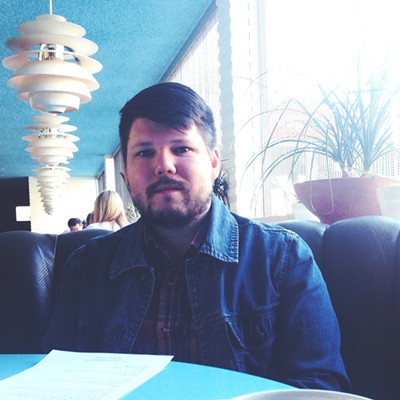As members of Vetiver, Daniel Hindman and Sarah Versprille explored the gauzy textures of Rumours-era Fleetwood Mac (occasionally recalling the hazy mysticism of the Peter Green era, too).
As Pure Bathing Culture, the duo fast-forwards the Mac dial to Tango in the Night o'clock. No, really: "Pendulum," which opens their full-length debut, Moon Tides, is the best "Little Lies" update Sirius XMU-core has offered up yet.
It's pure glide, with steady clap-beats clicking under Hindman's phased electric guitar and Versprille's Stevie Nicks-spins-Hounds of Love vocals. The reference points don't detract from the swooning ambiance of the album, but rather suggest familiar joys, adding to the sense that you've heard perfect tracks like the pulsing "Dream the Dare" and '90s R&B-evoking "Scotty" before.
In concert, the pair is joined by drummer Brian Wright and bassist Zach Tillman (brother to J. Tillman, a.k.a. Father John Misty), but on Moon Tides, it's just Versprille and Hindman with producer Richard Swift (solo, The Shins, Foxygen, Lætitia Sadier), whom they met while touring with Vetiver. The duo recorded at his National Freedom studio in Cottage Grove, Oregon, shortly after moving to the Pacific Northwest from New York. As such, it's a natural album, one that revels in West Coast mysticism and a lush greenness.
Hindman and Versprille discussed the record, the current state of music writing, and aesthetic completion.
You guys recorded with Richard Swift, who's an interesting producer. He's done a lot of different styles, and while I can hear a lot of his sonic touches on this, it sounds very much like you guys doing your thing. You guys utilized as many first takes as possible, right?
Daniel Hindman: Definitely. It was streamlined -- the whole process -- and I think that's something that Richard brought to the project. It was just a very natural, quickly recorded record. It's interesting; when people write bad reviews of the record or harp on it, they'll say, "This record sounds cheap." In this Pitchfork review, this guy wrote that we should be more like Chvrches or Haim or something, and it's funny, because we recorded the record in nine days.
It's weird to me to say the record is bad because it's not something that it isn't. It's something that was really naturally recorded. There's not a lot of heavy production. What's on the record is what we recorded in the studio. The way the sounds "sound" is the way we sounded when we recorded them, and the sounds we got with Richard in the studio. He encouraged us to be really natural. We're proud of it as our first record; I'm sure our next record is going to be more intensive.
One of the things I like about the record is that it's not as anesthetized or clean as so many other records in the genre. A little spontaneity adds something to it. There are some great songs on that Chvrches record, but it just sounds like it came out of a doctor's office.
DH: So much in music writing is about comparison. Going through this last cycle, we were fortunate enough to be covered by a lot of press, but so many people are writing about something other than your record. Particularly when they're writing negatively about your record. If someone is, like, a huge Beach House fan [they'll write a review focused on our record compared to Beach House's]. It's like, write about Beach House. You don't have to write about our record at all.
I imagine how strange it must be. As a writer, I get the desire to contextualize music, placing it in the landscape of music, but I don't know. At the end of the day, it is its own record.
It's such a strange thing. They write about 100 things that the record isn't, and there are a million things that the record isn't. There's more than 100. It's not Chvrches, it's not the White Album, either. It's a strange terrain to negotiate and deal with as an artist.
Sarah, your vocals are spot on. I know you favored natural sound, relying on first takes. Is it tough to be under the gun like that?
Sarah Versprille: Having worked on our EP with Swift, I knew that was going to be the case. All those vocals are first or second takes, and they're all complete passes. There's no editing, and very little punching on any of that. It is fun to do the vocal like that. A lot of the songs on the record we wrote just before going into the studio, so I had very little experience doing some of the songs. Now that we've been playing them live, they've been evolving and changing. That's just what the process of this record was. It was a really good mark of where we were at during the time that we made it.
There seems to be very intentional imagery associated with the band -- the album cover, the back cover, the insert. It feels like you're invoking a certain image or vibe. How did that play into the songs?
DH: I think it's a 50/50 thing with us being attached to and inspired by the imagery. It's all imagery from the Northwest: the Columbia River and shots from the coast. We moved here from New York and I think a big part of this record was us experiencing a change in our life and our surroundings. So, you know, that sort of spawned the idea. It's also us, you know, needing a cover. [Laughs] All of those images on the album cover and the press photos are shot on this infrared film that a friend of ours, Parker Fitzgerald, who's a photographer had. It's left over from Vietnam and they'd use it to shoot the jungles, and it would turn green things red. I guess that would help them to see weapons and stuff hidden in the jungle, and we had the idea to shoot these beautiful landscapes with the film.
It sort of evokes the old Windham Hill covers ...
SV: That was a direct influence.
DH: Totally. That was a starting point, and also old ECM covers were a big inspiration.
Visually, that ties you guys to a sort of new age element I hear in the music, too, a sort of "music as mood" motif. I think it fits the records in a natural way.
DH: It felt like a whole thing to us. The fact that the cover and the photos all come from one photo shoot, and the record session. In that sense we were striving to do something more like the way records were recorded in the past, in that sense. In order to make something that felt complete, and had that central feeling of "Here's the record, with all its flaws." It wasn't tinkered with endlessly in a thousand different ways. This is what we did.
Pure Bathing Culture is scheduled to perform Monday, October 14, at Rhythm Room.
Top 40 Songs with Arizona in the Title 9 Tips for Using A Fake ID To Get Into A Show Here's How Not to Approach a Journalist on Facebook The 30 Most Disturbing Songs of All Time
Like Up on the Sun on Facebook or follow us on Twitter for the latest local music news and conversation.










